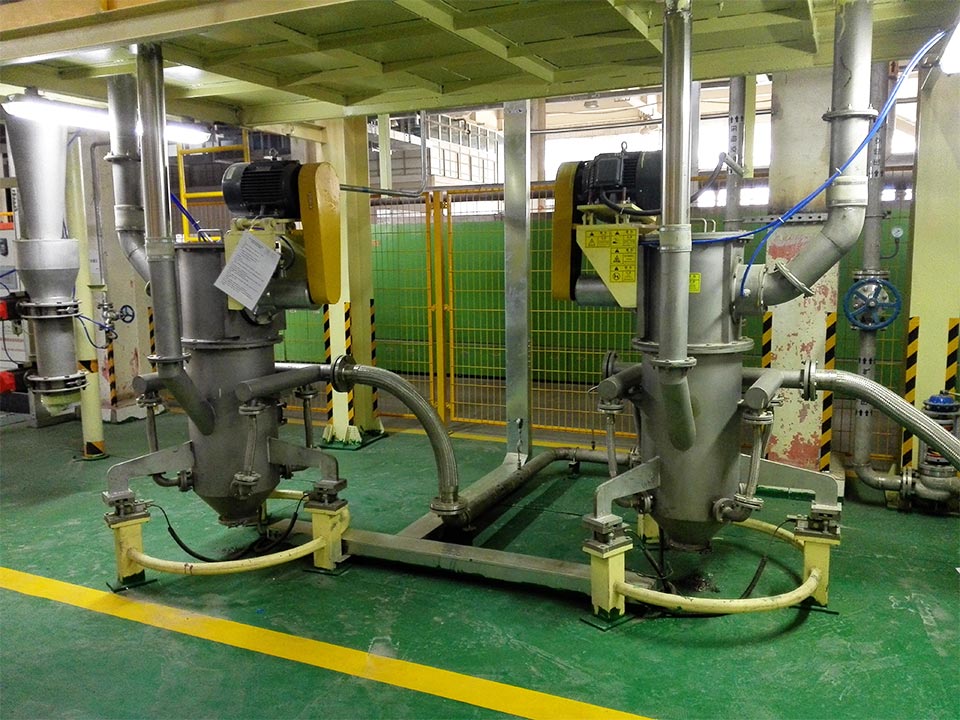Wide range of product applications for air classifiers
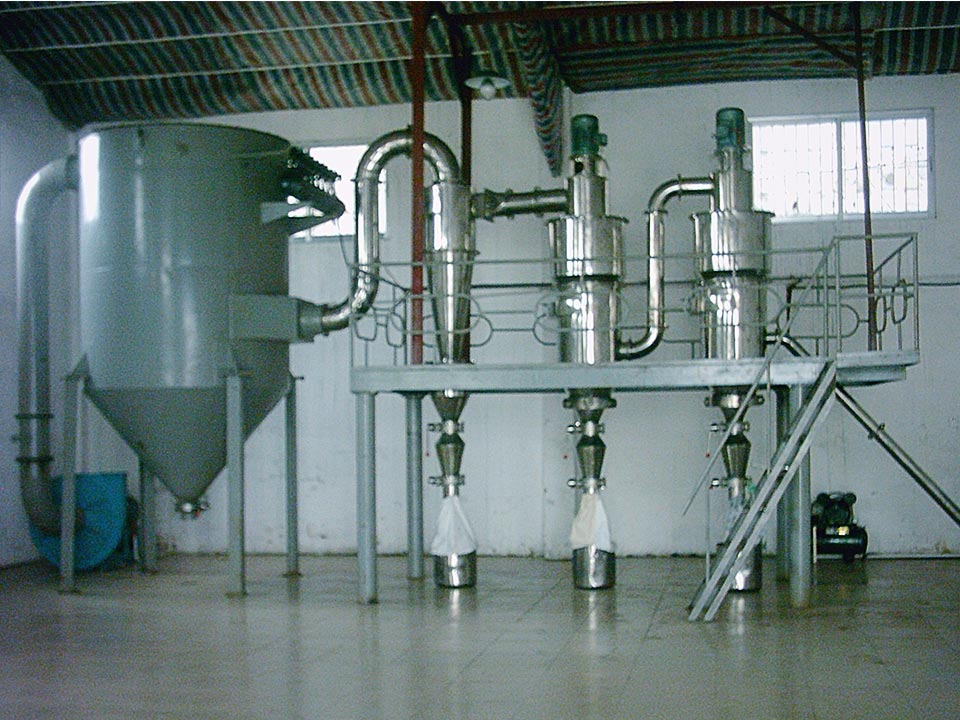
Features of Air Classifier:
1. Large output, low energy consumption and high grading efficiency.
2. Concentration of particle size: The machine uses an original vertical impeller for classification. The stable classification technology and special sealing measures effectively prevent the leakage of coarse particles, so that the product has no large particles, centralized particle size and high classification accuracy.
3. Reasonable structure: products with 1-6 particle sizes can be produced at the same time according to user requirements.
4. Strong applicability: It can be combined with various mills (jet mill, mechanical mill, ball mill, Raymond mill, vibration mill, etc.) to form a closed-circuit or open-circuit combined operation.
5. High degree of automation.
Working principle of air classifier:
Qualified fine powder is carried by the updraft into the turbo classifier above the fluidized bed. The classifier classifies qualified materials and enters the cyclone collector (if products with several particle sizes are required, multiple vertical turbines are added Classifier). The finer tail material is carried by the airflow into the bag filter. After being filtered by the bag, the tail material enters the discharge port at the lower part of the dust collector, and the pure air is emptied.
The main components of the machine: the standard configuration is a vertical turbine classifier. The crushing and classification are coordinated and completed synchronously. The speed of the classifier can be adjusted by frequency conversion, and the product fineness can be adjusted arbitrarily. If a processing process requires products with multiple granularities, two to four can be installed on the basis of a standard classifier to make this machine a two-connected-five-connected crushing and grading machine.
Application range: The crushing mechanism of this machine determines its wide application range and high fineness of the finished product. Typical materials include: superhard diamond, silicon carbide, metal powder, etc., high purity requirements: ceramic pigments, medicine, biochemical Etc. Low temperature requirements: medicine, PVC. By changing the ordinary air in the air source to inert gases such as nitrogen and carbon dioxide, the machine can be used as an inert gas protection device, suitable for the crushing and classification of inflammable, explosive, and oxidizable materials.
Airflow classifier product application:
1. High hardness materials: silicon carbide, various corundum, boron carbide, alumina, zirconia, garnet, zircon sand, diamond, etc.
2. Non-metallic minerals: quartz, graphite, kaolin, calcium carbonate, mica, barite, mullite, medical stone, wollastonite, talc, pyrophyllite, etc.
3. Chemical industry: aluminum hydroxide, silica gel, various dyes, epoxy resin, various additives, etc.
4. Food and medicine: pollen, hawthorn, pearl powder, Ganoderma lucidum, various vegetable powder, various Chinese herbal medicines, various health products, cosmetics, antibiotics, etc.
5. Metal materials: aluminum powder, magnesium powder, zinc powder, tin powder, copper powder, etc.
6. Other materials: ceramic materials, refractory materials, electronic materials, magnetic materials, rare earth materials, phosphors, copy material powders, etc.
Ultra-fine grinder operating instructions & output & fineness adjustment methods
Ultra-fine grinder is a kind of fine powder and ultra-fine powder grinding and processing equipment. This equipment is mainly suitable for non-flammable and explosive non-metallic materials with medium and low hardness, humidity less than 6%, and Mohs hardness below 9 .

- Operation instructions
(1) Turn on sequence ---- turn on the auxiliary equipment first (high-voltage extension, high square screen, pulse dust collector, wind shutoff, screw auger, scraper and hoist).
(2) Open the host supporting equipment (grading wheel, host, feeder). Remarks: Before turning on the feeder, the frequency of the grading wheel must be set first. The purpose is to prevent the grinding material from being too coarse or too fine.
- Fineness adjustment method
(1) Under normal working conditions, the factors that affect the fineness are the air volume, the speed of the grading wheel and the feeding volume, and the degree of wear of the wearing parts.
(2) When the fineness is too thick: if the air volume is the maximum, first reduce the feed volume, and then increase the frequency of the grading wheel; if it still does not meet the requirements, turn off the small air volume (butterfly valve on the high-pressure air pipe). Such repeated adjustments to find and meet the fineness requirements are the control points for the best yield.
(3) When the fineness is too fine: first increase the air volume, if the air volume is the largest, reduce the frequency of the grading wheel and increase the feeding volume after the current drops. Such repeated adjustments to find and meet the fineness requirements are the control points for the best yield.
(4) If low-grade feed is produced, the requirement for fineness is not high, and when only the output is pursued, the air volume should be maximized, the frequency of the grading wheel should be reduced, and the feed volume should be increased.
- Wearable parts and names that affect output and fineness
(1) Hammer: After the material enters the grinding chamber, the hammer is mainly used to make the material thinner. Severe wear of the hammer head will result in a decrease in output and fineness, uneven wear and increase in vibration, which will affect the service life of the main engine bearing.
(2) Ring gear: After being hit by the hammer, the material will bounce back to the ring gear, forming a second hit, and the crushing requirements can only be reached after repeated such repetition. The wear of the ring gear will greatly affect the output and fineness.
(3) Wear plate: Wear plate is the most easily worn object. Wear plate is an important part to protect the active disk. Excessive wear of the wear plate will increase the vibration and affect the service life of the main engine bearing. After being worn through, the active disc will be directly worn, which will increase the cost of accessories and cause the equipment to operate in a dangerous state.
(4) Shunt cover: After the shunt cover is worn, it will change the flow direction of the airflow in the crushing chamber, causing the fineness of the material to fail to meet the requirements.
(5) Active disk: The wear of the active disk (replacement of the wear plate in time will effectively protect the active disk) will cause vibration and affect the service life of the host bearing.
How to solve the problem of excessive dust when the jet mill is working
The jet mill, cyclone separator, dust collector, and induced draft fan constitute a complete pulverization system. After the compressed air is filtered and dried, it is sprayed into the crushing chamber at high speed through the Laval nozzle. At the intersection of multiple high-pressure airflows, the materials are repeatedly collided, rubbed, and sheared to be crushed. The crushed materials rise with the suction of the fan. The air flow moves to the classification zone, and the coarse and fine materials are separated under the strong centrifugal force generated by the high-speed rotating classification turbine. The fine particles that meet the particle size requirements enter the cyclone separator and dust collector through the classification wheel for collection, and the coarse particles descend to the grinding zone to continue grinding .
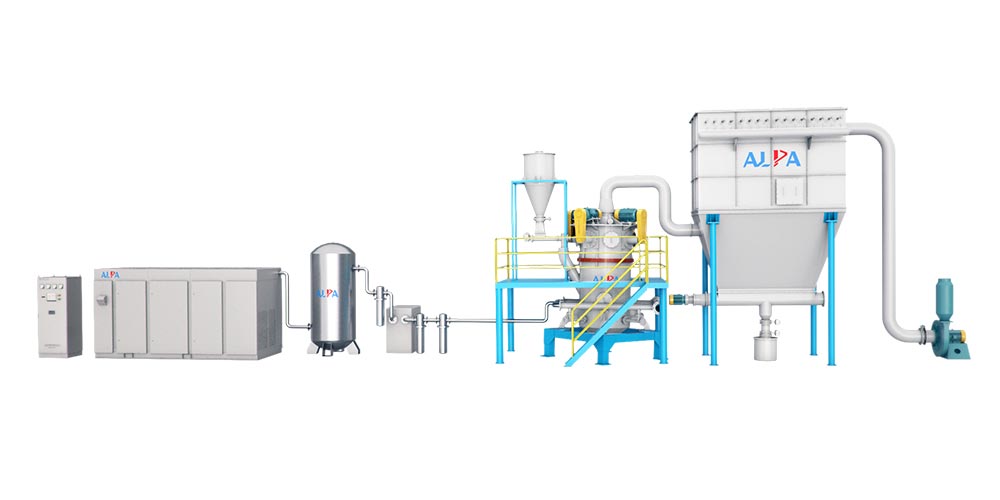
Sometimes the difference in operation mode and settings will make the crusher's crushing effect poor. Whether it is to increase the speed of the extension or set the parameters, it will not achieve good results. So what to do in this situation, let me tell you about it below. Ways to improve the crushing effect.
To increase the feed rate, the principle of airflow pulverization mainly relies on the high-speed airflow to cause strong collisions between the material and the material, and the material and the inner wall to achieve the pulverization effect. If the feed is too little, the purpose of frequent and strong collisions cannot be achieved, so that the strength cannot be lowered. In addition, if the fan damper is too large, the internal negative pressure will be too large and the collision will be reduced; on the contrary, the positive pressure is not good.
The jet mill is used to crush materials, so the crushed materials and tailings must be discharged in time. When the crusher discharges these crushed materials, there will be dust. So how to solve if the dust is too large?
- Install the dust collector: Generally, this type of dust collector can be used with a grinder. It collects the dust in the collection bag, and the dust is filtered and discharged from the dust box through the cloth bag;
- The cloth bag is dustproof: the cloth bag is tightly tied to the powder outlet of the machine to prevent air leakage and powder leakage. Attention should be paid during operation: the powder outlet should be blocked when parking, and the dust should be cleaned up in time.
- Dust removal by wood shower or pool: Mainly use a ventilator to vacuum to the outside of the grinding room, and then use a spray to vacuum, or use a pool to vacuum, etc.
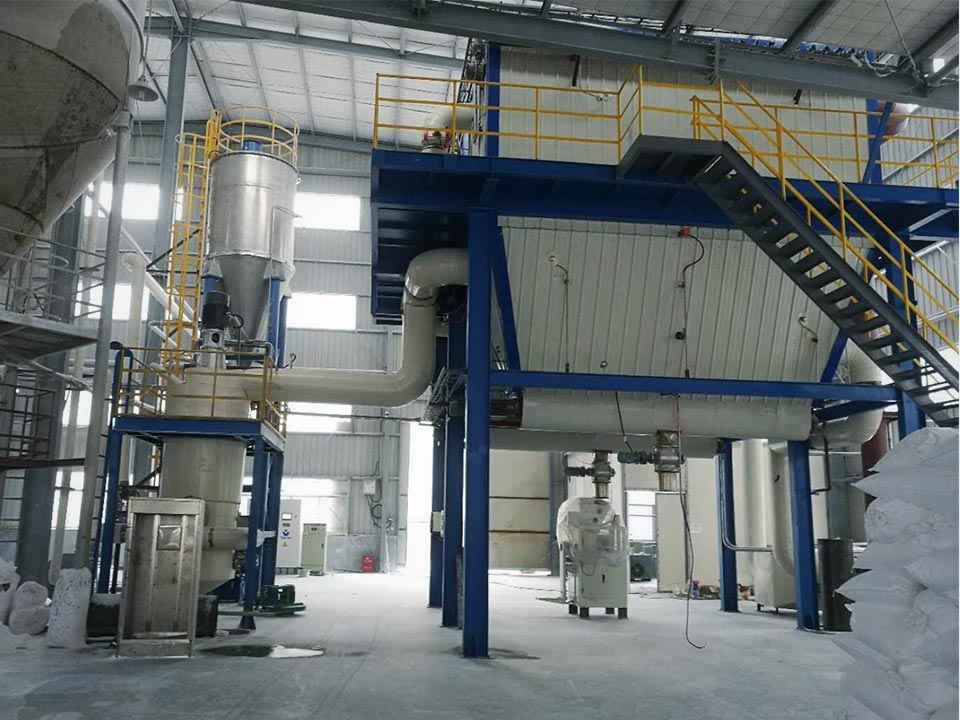
The above three dust removal methods can achieve good dust removal effects and can solve the problem of excessive dust. Generally, these dust removal devices are installed before work to prevent excessive dust.
What are the factors that affect the output and quality of the ball mill?
The beneficiation stage is mainly divided into three stages: pre-selection, separation and post-selection. Grinding is in the pre-selection stage. Therefore, the output of the ball mill has a certain degree of influence on the mineral separation effect, and even the recovery rate and concentrate grade. Therefore, how to ensure the output of the ball mill has become a topic of concern, so what are the reasons that affect the output of the ball mill?
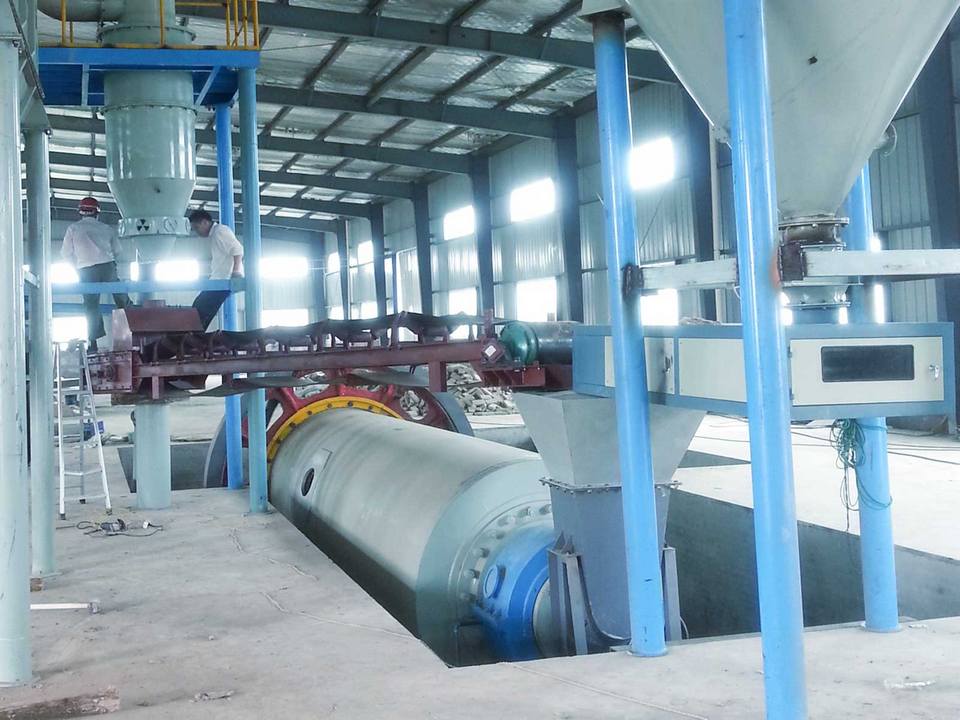
- Raw material size
The particle size of the raw material affects the output and quality of the ball mill. If the particle size is small, the output and quality of the ball mill will be high, and the power consumption will be low; if the particle size is large, the output and quality of the mill will be low, and the power consumption will be high.
- Material ease of grinding
The grindability of the material refers to the degree of difficulty of the material in the grinding process. According to the national standard, the grindability index wi (kWh / T) is adopted. The smaller the value, the better the grind, otherwise the harder it is to grind.
- The water content of the material to be ground
The grinding of the ball mill can be divided into two methods: dry and wet. For dry milling, the water content of the abrasive has a great influence on the output and quality of the mill. The higher the water content of the abrasive material, the more likely it is to cause full grinding or paste grinding, reducing the grinding efficiency, and the lower the output of the grinding machine. Therefore, materials with higher moisture must be dried before grinding.
- Feed temperature
If the temperature of the material entering the mill is too high, the impact friction of the grinding body will be generated. If the temperature in the mill is too high, the ball will stick, which will reduce the grinding efficiency of the mill and affect the output of the mill. At the same time, the thermal expansion of the rolling mill barrel affects the long-term safe operation of the rolling mill. Therefore, it is necessary to strictly control the temperature of the material being ground.
- The fineness requirements of the grinding material
The finer the requirements for fineness, the lower the output, and vice versa, the higher the output. In some areas, excessive emphasis on fineness does not meet the requirements of economic production. For example, in the cement industry, actual production shows that when the product fineness is in the range of 5-10%, the fineness is reduced by 2%, and the output will be reduced by 5%. When the fineness is controlled below 5%, the output of the mill will decrease even more. Therefore, choosing the right product fineness is also an important factor to improve the output and quality of the ball mill.
- Grinding process
For ball mills of the same specifications, the closed-circuit process can increase the output by 15-20% compared with the open-circuit process; in closed-circuit operation, selecting the appropriate separation efficiency and cycle load rate is an important factor in increasing the output of the mill.
- Powder selection efficiency
The sorting efficiency of the closed-circuit crusher has a great influence on the output of the crusher. Generally speaking, the efficiency of the classifier is higher, which can improve the grinding efficiency of the mill. However, the classifier itself cannot play the role of grinding, so the function of the classifier must be combined with the grinding function of the grinder to increase the output of the grinder. Production practice shows that the efficiency of the one-stage closed-circuit long grinding separator is generally controlled at 50 ~ 80%. The ideal separation efficiency should be determined through multiple experiments.
- Cycle load rate
Circulation load rate refers to the ratio of recycled powder (coarse powder) to finished product. In order to improve the grinding efficiency of the mill and reduce the phenomenon of over-grinding in the mill, the cycle load rate should be appropriately increased. However, if the circulating load rate is increased to a very high level, there will be too much material in the mill, thereby reducing the grinding efficiency.
- Add grinding aid
Some grinding aids will affect the grinding effect, because most of the organic substances of commonly used grinding aids have strong surface activity, which can accelerate the crack propagation of the material and reduce the amount of fine powder during the grinding process of the adsorbed material on the surface of the material. The mutual combination between the two improves the grinding efficiency, which is conducive to the energy-saving and high-yield of the ball mill.
- Ball to material ratio
The ball-to-material ratio is the ratio of the mass of the grinding body to the mass of the material. If the ball-to-battery ratio is too large, it will increase the useless work loss of the impact friction between the grinding body and the liner, increase power consumption and reduce output. How to choose the ball-to-battery ratio and ball-to-battery ratio of the ball mill is a common problem in actual production.
In addition to process factors, the model, parameters, and the work of production and maintenance personnel also affect the production and quality of the ball mill. The energy-saving and high-yield ball mill is a systematic project, and each link is interrelated and restricts each other. Only comprehensive consideration and close cooperation can achieve better energy-saving and high-yield effects.
How to deal with the blockage of jet mill
There are many grinders in our daily life, such as small grinders, Chinese medicine grinders, jet grinders, and so on. But in the process of use, sometimes there will be some failures, sometimes the grinder is blocked, when it is blocked, how should we deal with it? In fact, clogging is a very common failure of the grinder during grinding, and the main reason is still caused by the operation.
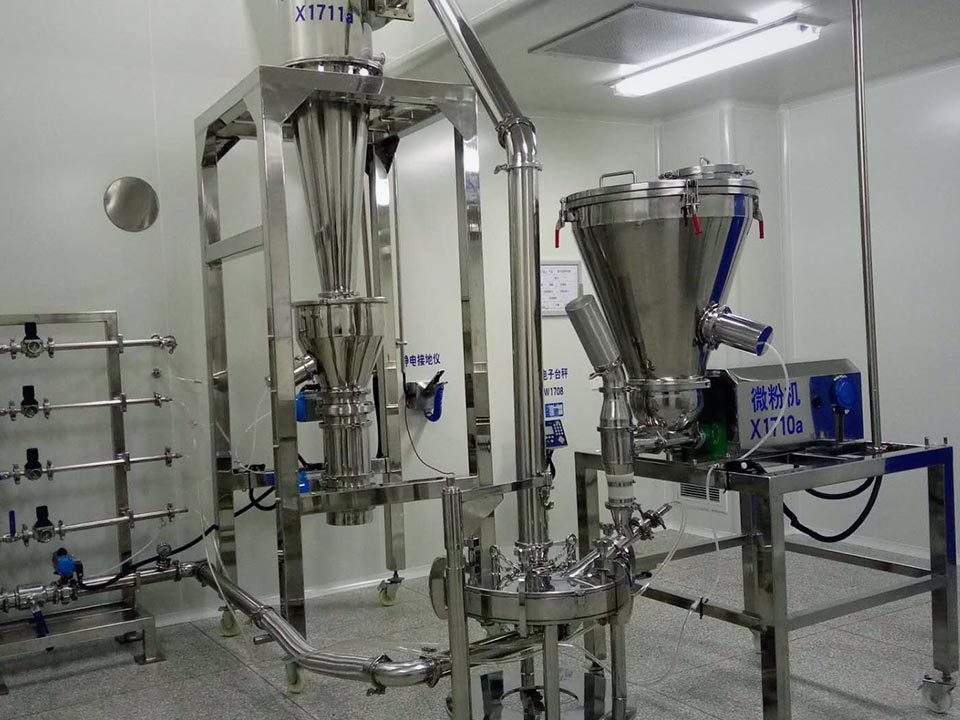
1. The feeding speed is too fast and the load increases, causing blockage. During the feeding process, you should always pay attention to the large deflection angle of the ammeter pointer. If it exceeds the rated current, it indicates that the motor is overloaded, and the motor will be burnt if overloaded for a long time. In this case, the feed door should be reduced or closed immediately, or the feeding method can be changed, and the feed amount can be controlled by increasing the feeder. There are two types of feeders: manual and automatic. The user should choose the appropriate feeder according to the actual situation. Due to the high speed of the grinder, the large load, and the strong fluctuation of the load. Therefore, the current when the grinder is working is generally controlled at about 85% of the rated current.
2. The discharging pipeline is not smooth or blocked and the feed is too fast, which will block the tuyere of the grinder; improper matching with the conveying equipment will cause the discharging pipeline to weaken or become blocked after no wind. After the fault is detected, the unmatched conveying equipment should be cleared first, and the feeding amount should be adjusted to make the equipment operate normally.
3. The broken or aging of the hammer, the closed or broken screen mesh, and the high water content of the ground material will cause the grinder to be blocked. The broken and severely aged hammers should be updated regularly, the grinder should be kept in good working condition, and the screen should be checked regularly. The water content of the ground material should be less than 14%, which can improve production efficiency, prevent the grinder from clogging, and enhance the reliability of the grinder.
These are the ways to deal with the clogging of the grinder. It is very common for the machine to malfunction. The most important thing is that we must know the way to solve the problem. This is a factor that makes the grinder longer service life. In addition, maintaining the machine is also very important.
Common problems of ball mills and solutions to failures
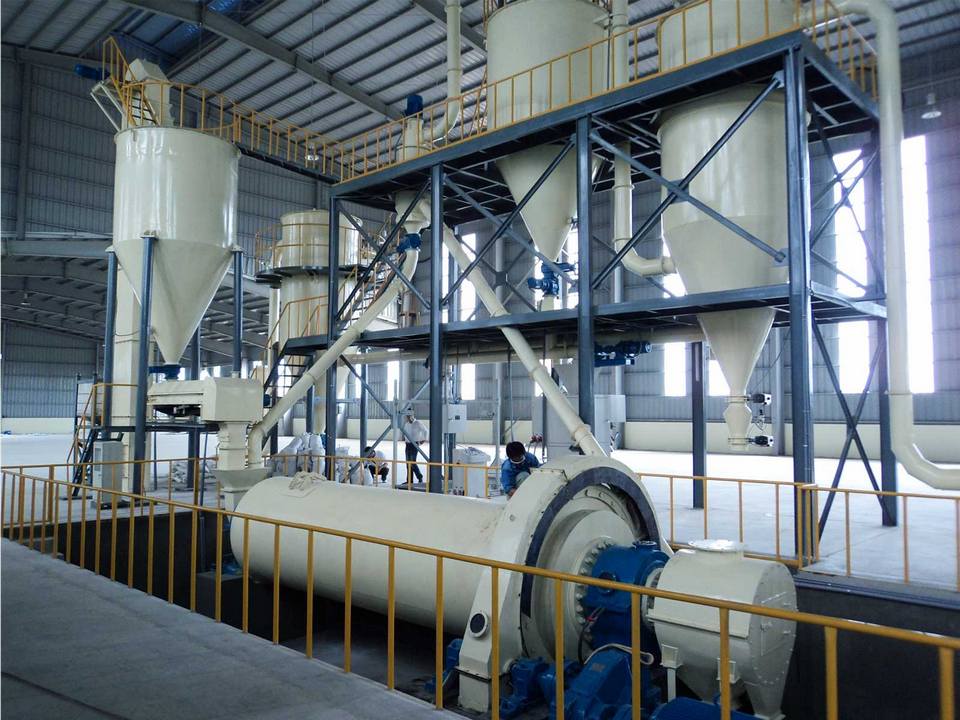
1. When the ball mill is running, there is a regular percussive sound, and the sound is loud. When the ball mill rotates, the liner hits the grinding cylinder of the ball mill. Judge the position of the liner of the ball mill according to the sound, find out the loose bolts and tighten them separately.
2. The temperature of the bearings of the ball mill and the motor has risen, exceeding the requirements. Try to feel the bearing by hand. If the temperature is too high, check and handle the ball mill from the following points.
(1) Check the lubrication points of each part of the ball mill, and check whether the brand of lubricating oil used is consistent with the factory instructions.
(2) Check whether the lubricating oil and grease of the ball mill have deteriorated.
(3) Check whether the lubrication pipeline of the ball mill is blocked, or the lubricating oil does not directly enter the lubrication point, and the insufficient amount of oil causes heat.
(4) The side clearance of the bearing bush of the ball mill is too small, the clearance between the bearing bush and the shaft is too large, and there are too many contact points, forming a uniform oil film on the bearing bush.
(5) Too much or too little grease in the rolling bearing of the ball mill will form rolling elements. Stirring the grease will generate heat, and the heat is not easy to disperse. If the lubrication is too little or poor, add enough oil according to the regulations, generally 1/3 ~ 1/2 of the bearing clearance.
(6) The sealing device of the hollow shaft at both ends of the ball mill body is too tight, or the iron part of the sealing body is in direct contact with the shaft.
The above problems should be dealt with in an appropriate way. Only when the side clearance of the bearing bush is too small or the bottom contact angle is too big, an oil jack must be used to lift the grinding cylinder, and the bearing bush should be drawn out from one side of the shaft and scraped separately.
3. The bearing of the reducer of the ball mill is overheated: In addition to checking the temperature rise of the bearing of the ball mill, check whether the vent of the reducer is blocked and clear the vent.
4. The ball mill motor produces vibration after starting, the main reasons are as follows:
(1) The gap between the two wheels of the ball mill coupling is too small to compensate for the displacement caused by the self-seeking core when the motor is started.
(2) The alignment method of the ball mill coupling is incorrect, which causes the two shafts to be misaligned.
(3) The coupling bolts of the ball mill are tightened asymmetrically, and the tightening force is different.
(4) The outer ring of the ball mill bearing moves.
Treatment method: Adjust the gap between the two wheels as required to make the two shafts concentric. Tighten the coupling bolts symmetrically with the same torque.
When the rotor is unbalanced, the ball mill rotor should be pulled out for static balance.
5. The ball mill reducer drives the ball mill to produce greater vibration
(1) The balance shaft of the ball mill and the reducer is not in a straight line
When the mill was installed with the liner, the secondary grouting was not carried out, or the anchor bolts were not tightened after the secondary grouting. Rotating the mill barrel with a hoist causes one end of the mill barrel to shift, and the two shafts are not in a straight line. The reducer drives the mill to cause vibration.
Treatment method: readjust so that the axis of the ball mill and the axis of the reducer are on the same plane axis.
(2) Large-scale ball mills are bulky and heavy, causing the foundation to sink and shift. Set up a settlement monitoring point next to the foundation, observe and adjust when the settlement is found.
6. Abnormal running sound of ball mill reducer:
The normal operation sound of the ball mill reducer should be uniform and stable. If there is a slight knocking sound or hoarse friction sound on the gear, there is no obvious change during operation, you can continue to observe, find out the cause, and stop the ball mill for processing. If the sound becomes louder, stop the ball mill inspection immediately.
What are the irreplaceable functions of the jet mill
Jet mills are widely used in chemical, mineral, metallurgy, abrasives, ceramics, refractory materials, medicine, pesticides, food, health products, new materials and other industries. The reason why it is chosen as the factory production equipment is that the jet mill does have an irreplaceable role.
The working principle of the jet mill: Qualified fine powder is brought into the turbo classifier on the upper part of the fluidized bed by the updraft, and the qualified materials are classified by the jet mill and enter the cyclone collector. A vertical turbine classifier). The finer tailings are brought into the bag filter by the airflow, and after being filtered by the bag filter, the tailings enter the discharge port at the lower part of the filter, and the pure air is evacuated.

The main components of the machine: standard vertical turbine classifier, grinding and classifying are coordinated and completed simultaneously. The speed of the powder concentrator can be adjusted by frequency conversion, and the fineness of the product can be adjusted arbitrarily. For example, if a processing process requires products with multiple particle sizes, you can add two to four more than one classifier as the standard, so that the machine becomes a two-machine five-machine for grinding and classification.
Scope of application: The grinding mechanism of the jet mill determines its wide application range, with high fineness and high purity of the finished product. Typical materials include superhard diamond, silicon carbide, metal powder, ceramic pigments, medicine, biochemistry, etc. By changing the ordinary air in the gas source into inert gases such as nitrogen and carbon dioxide, the machine can be used as an inert gas protection device, suitable for the grinding and classification of flammable, explosive, and oxidizing materials.
Application of jet mill:
- High hardness materials: silicon carbide, various corundum, boron carbide, alumina, zirconia, garnet, zircon sand, diamond, etc.
- Non-metallic minerals: timing, graphite, kaolin, calcium carbonate, mica, barite, mullite, medical stone, wollastonite, talc, pyrophyllite, etc.
- Chemical industry: aluminum hydroxide, silica gel, various dyes, epoxy resins, various additives, etc.
- Food and medicine: pollen, hawthorn, pearl powder, Ganoderma lucidum, various vegetable powder, various Chinese herbal medicine, various health products, cosmetics, antibiotics, etc.
- Metal materials: aluminum powder, magnesium powder, zinc powder, tin powder, copper powder, etc.
- Other materials: ceramic materials, refractory materials, electronic materials, magnetic materials, rare earth materials, phosphors, copy material powders, etc.
Features of air classifier:
- Large output, low energy consumption and high classification efficiency.
- Concentrated particle size: This machine uses the original vertical impeller for classification. The stable classification technology and special sealing measures effectively prevent the leakage of particles, so that the product has no large particles, the particle size is concentrated, and the classification accuracy is high.
- Reasonable structure: products with 1-6 granularities can be produced at the same time according to user requirements.
- Strong applicability: It can be combined with various mills (jet mill, mechanical mill, ball mill, Raymond mill, vibration mill, etc.) to form a closed-circuit or open-circuit joint operation.
- High degree of automation.
Preparation and inspection of the superfine grinder before use
Jet mills use high-speed airflow to perform ultra-fine grinding of materials. At present, there are five types in the industry, which can be divided into horizontal disc (flat) jet mills, circulating tube jet mills, target jet mills, reverse jet mills and fluidized bed jet mill. The ultra-fine grinder uses air separation, heavy pressure grinding, and shearing to achieve ultra-fine grinding of dry materials. It is composed of cylindrical grinding chamber, grinding wheel, grinding rail, fan, material collection system and so on.
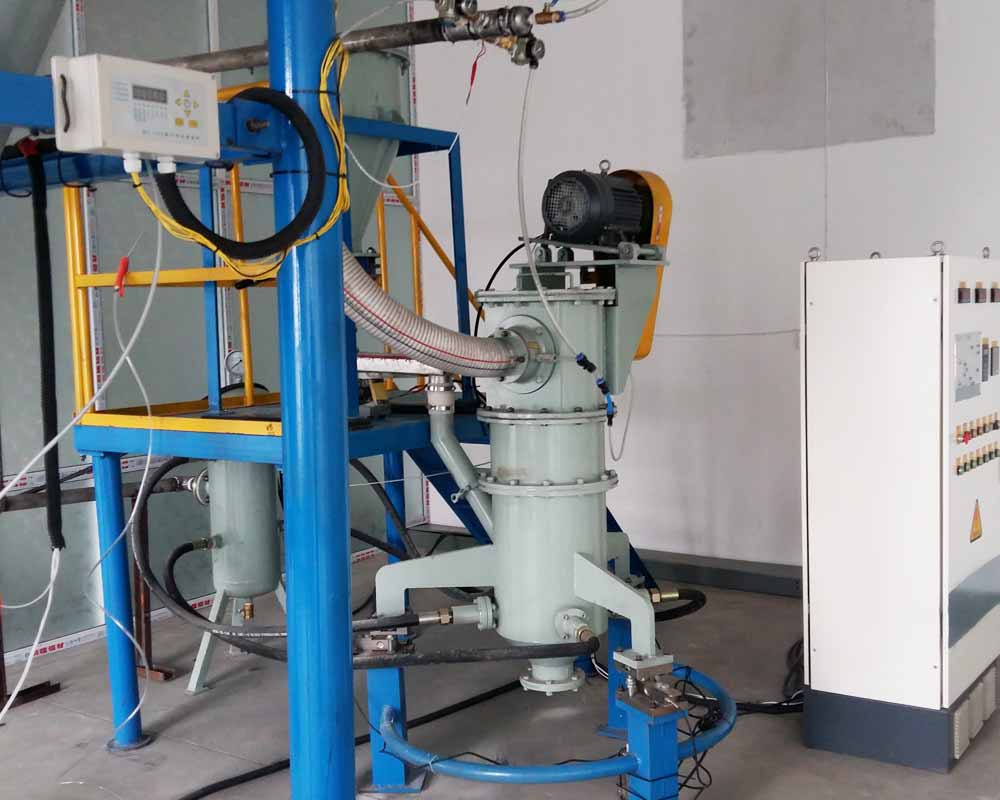
The inspection items before preparation and use are as follows:
1. Check the grinder and grading system to check whether there are metal objects and debris in the grinding room;
2. Check whether there are metal objects and sundries in the feeding hopper and feeding screw of the superfine grinder;
3. Check whether the ultra-fine grinder tightens the fasteners;
4. Whether the elasticity of the transmission belt of the ultra-fine grinder is moderate, and whether the protective cover has been installed;
5. Check the collision of the transmission parts, if there is any abnormality, analyze the reason and eliminate it in time;
6. Turn the transmission parts to see if there is any abnormality, then move the parts to check whether the operation direction is correct;
7. Run the ultra-micro grinding machine without load for 20-30 minutes, and observe the working current, temperature and vibration: the temperature rise of the spindle bearing should not exceed 35℃, and the highest target temperature should not exceed 70℃ (in different environments, the temperature is generally not more than 40 ℃); The vibration amplitude of machinery and equipment should not be too large. It can be put into production after normal no-load operation;
8. The superfine grinding machine should properly open the upper and lower air doors of the gravity dust collector room.
The application of ultra-fine grinding machine in the pharmaceutical industry
The medical ultra-fine grinder used in the development of medical resources can produce micron-level powder, which can destroy the structure of the tissue cell wall and obtain the required material characteristics.
The medical ultra-micro grinder uses compressed air to be cooled, filtered, and dried. The nozzle forms a supersonic airflow and is injected into the crushing cavity. The material is fluidized under the action of pressure difference. The accelerated material is at the intersection of multiple nozzles. Converge, produce fierce impact, collision, friction, and shear to achieve ultra-fine grinding of particles, which can be used to produce various micron-level powders. The medical ultra-fine grinder is used for ultra-fine pulverization and wall-breaking processing of various types of medicine; improvement of drug solubility; ingenious confusion and evacuation of compound drugs; manufacture of film ointment, etc.
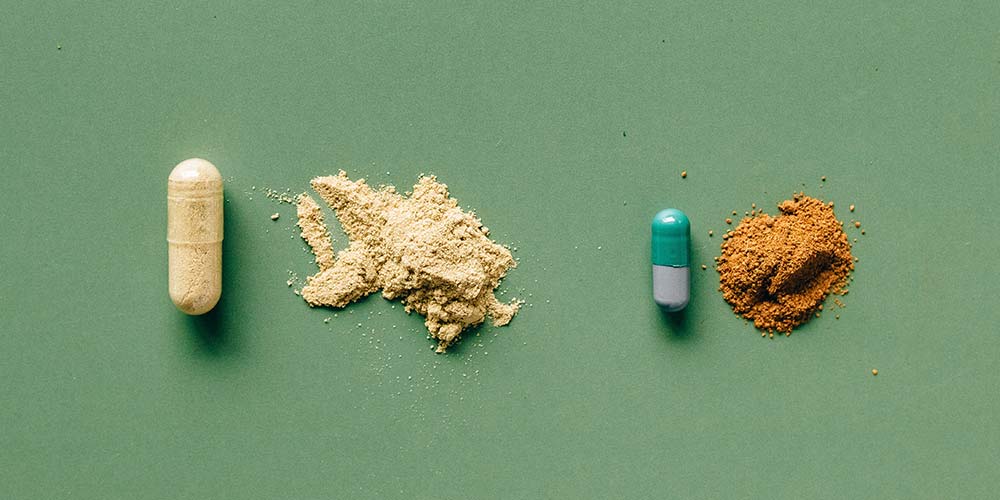
The scope of use is:
Chinese herbal medicine: Typical materials include American ginseng, ginseng, Ganoderma lucidum, pearls and other valuable materials and pollen, hawthorn, shiitake mushrooms, pearl powder, gallnut, multiflorum multiflorum, Andrographis paniculata, mint, houttuynia cordata, fern root, kudzu root, dry alum, yam, white peony root , Lotus leaf, white tuckahoe, Tianqi, Angelica dahurica, honeysuckle, cordyceps, saffron, cuttlefish, fumarole, Radix isatidis, etc.
Western medicine: Typical materials include stomach medicine, nimodipine, antibiotic medicine, contrast medicine, etc.
- The medical ultra-fine grinderis small in size, light in weight and easy to operate.
- The medical ultra-fine grinderhas low vibration and impact and low noise.
- The medical ultra-fine grinderhas high frequency, large amplitude and high efficiency. The discharging granularity is fine and the distribution is even.
- The medical ultra-fine grinderis equipped with unique feeding and discharging ports, which is convenient for dust-free collection.
- Intermittent sealed grinding of pharmaceutical ultra-fine grinder may also be continuous open-circuit grinding.
- The medical ultra-fine grinderis easy to clean. The grinding drum can be removed and opened to facilitate cleaning and disinfection without leaving dirt.
- The grinding cylinder of the medical ultra-fine grinderis made of stainless steel. The ultra-fine grinderuses air separation, heavy pressure grinding, and shearing to achieve ultra-fine grinding of dry materials. It is composed of cylindrical crushing chamber, grinding wheel, grinding rail, fan, material collection system and so on. The jet mill uses high-speed airflow to superfinely grind materials to ensure no wear and pollution.
Selection of medical crusher equipment:
According to the physical characteristics of medicine, two kinds of equipment are used for grinding processing. For sugar-free and oil-free products, the grading impact mill (effectively reducing the energy consumption of production equipment) can achieve the grinding effect; for sugar-containing and oily products, use a fluidized-bed jet mill (low crushing temperature) , Oiliness and sugar will not melt during ultra-fine grinding, resulting in adhesion of equipment) for grinding processing.
Application of Talc in Plastic Modification
As an additive, modifier or filler, talc has been widely used in papermaking, paint, coatings, ceramics, daily chemicals, plastics, food, medicine and other industries. Talc has the advantages of soft texture, low abrasion, high gloss, low oil absorption, and good transparency.
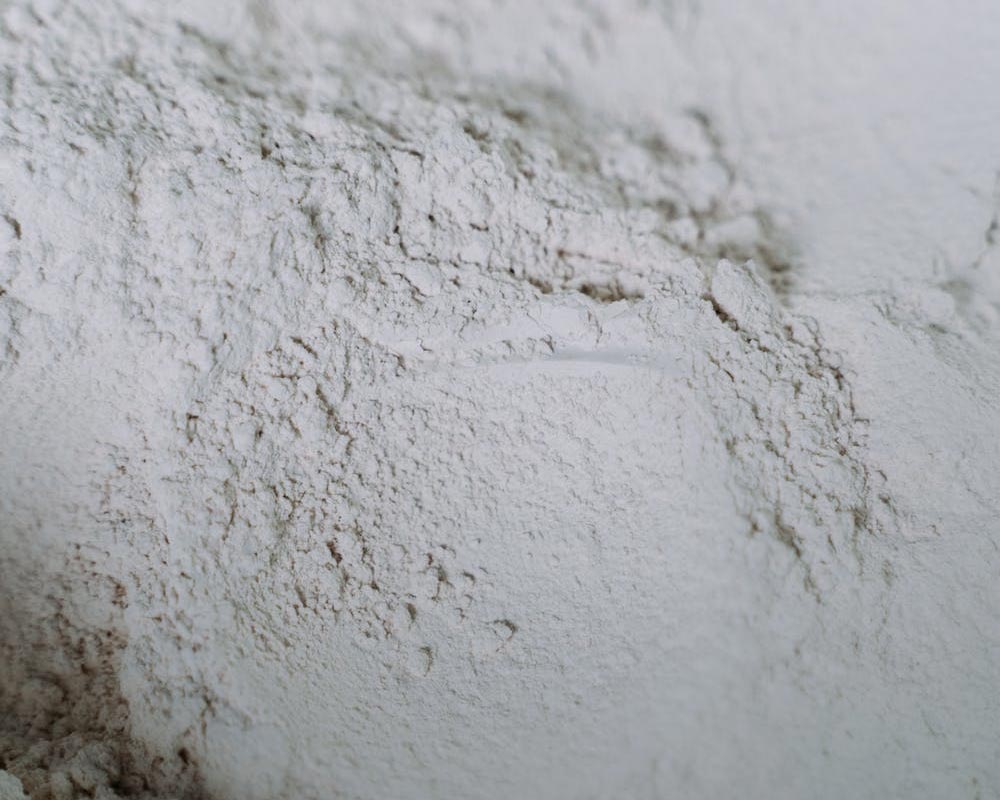
Four properties of talcum powder
- Enhance
The significant enhancement effect of talc on plastic products mainly comes from its unique microscopic flake structure. The more complete the flake structure of the processed talc powder is, the more obvious the enhancement effect will be. A larger diameter-to-thickness ratio (the ratio of the average diameter of the flake particles to their thickness) can improve the rigidity, impact strength, flexural modulus and thermal stability of plastic products.
- Insulation, barrier
Insulates and blocks high-quality ultra-fine talcum powder into a flake structure. When used in plastic products, it can be uniformly dispersed in the resin in a layered form. Just like the metal structural net embedded in cement products, in addition to maintaining the advantages of plastic, it also has obvious heat preservation and barrier effects.
- Nucleation
The slippery feeling of talc is very obvious, the opening of the plastic added with talc is obviously improved, and the anti-blocking property of the film can also be improved. When ultra-fine talcum powder (below 1μm) is uniformly dispersed in the plastic matrix, it can act as a nucleating agent.
- Anti-aging
Talc, mica, kaolin and other silicon-containing minerals have infrared and ultraviolet barrier properties, and have obvious effects of heat preservation and aging resistance in plastic products.
Reasons for choosing talcum powder
- Structure
Since the crystalline structure of talc is layered, it has a tendency to split into scales and special lubricity. When used in plastic products, it can be uniformly dispersed in the resin in a layered manner, and has good compatibility with the resin. The complementarity of properties and mechanical properties can improve the physical properties of plastic products.
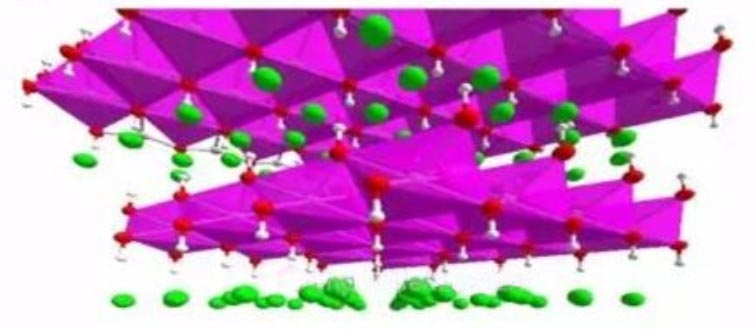
- Silica content
The silicon content in talc powder is an important indicator to measure the grade of talc powder. The higher the silicon content in talc powder, the higher the purity of talc, the better the application effect and the higher the price. Customers need to choose talcum powder according to the performance requirements of different plastic products.
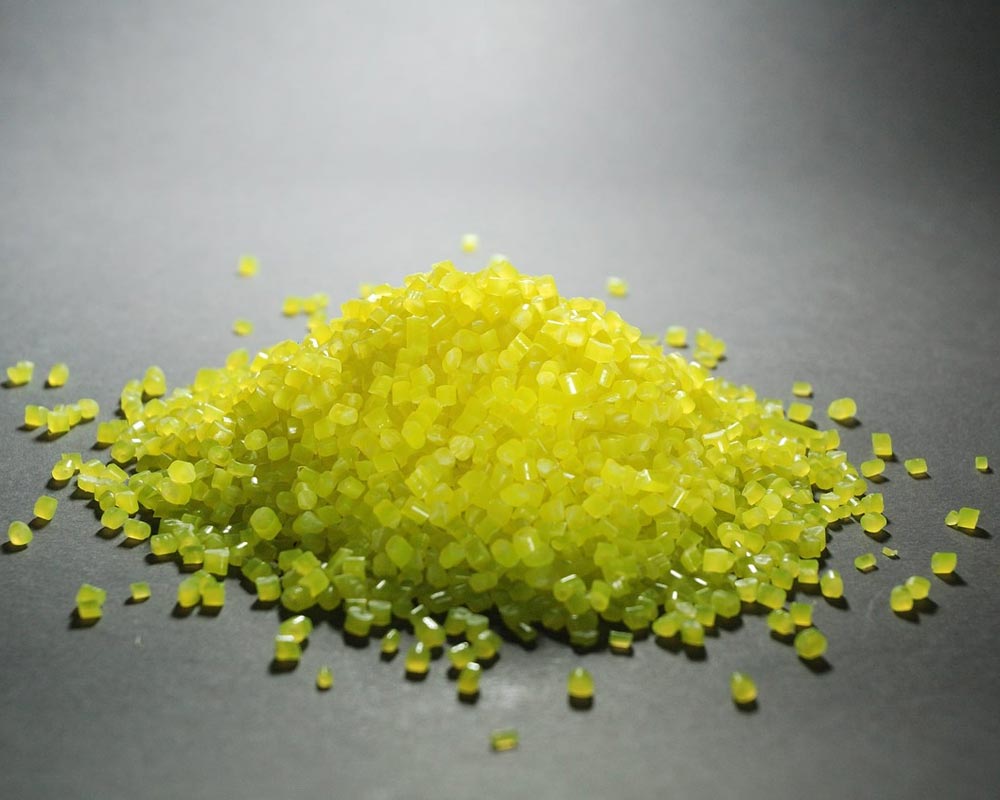
- Colour
The color of raw talc powder can be white, gray, light red, pink, light blue, light green and other colors, and has different degrees of solid luster. This color can improve the appearance and visual effect of the product.
- Surface properties
The larger specific surface area and appearance structure of talc powder will not only affect the amount of additives, but also promote the bonding force between the resin structures, thereby improving the physical properties of plastic products.
The influence of talcum powder on plastic properties
- Improve the molding shrinkage rate of plastic products
As the content of talc powder increases, the shrinkage rate of polypropylene plastics gradually decreases. The addition of talc powder increases its viscosity and decreases creep properties, thus reducing the crystallinity of the plastic; talc powder itself has no shrinkage, thus Reduce the overall material molding shrinkage.
- Surface hardness and surface scratch resistance
Surface hardness and surface scratch resistance are requirements for certain plastic products. Adding talc to polyethylene and polypropylene plastics can effectively improve the surface hardness and surface scratch resistance of products.
- Flexural modulus
The addition of white talc with flake structure to any kind of plastic can significantly increase its flexural modulus. For general mineral filling, this is the most significant feature of talc.
- Tensile Strength
The content of talc powder within a certain range can increase the tensile strength. After adding 1500 mesh activated talc to polypropylene, the tensile strength of the material changes. When the content of talc powder is less than 20%, the tensile strength of the material increases slightly. When the content of talc powder is above 20%, the tensile strength of the material gradually decreases as the content increases. The main reason is that the talc powder further increases, which weakens the polypropylene. Caused by the intermolecular gravitation.
- Impact strength
The effect of talc on the impact strength of plastic materials is similar to the effect of talc on the tensile strength of plastic materials. When the content of various mineral additives is less than 10%, they all have an effect on improving the impact toughness. When the content is greater than 10%, the impact performance begins to decrease.
- Deformation temperature
Talc has a significant effect on the thermal deformation temperature of plastic materials, and can effectively increase the thermal deformation temperature of various plastics, thereby increasing the heat resistance of plastics.
Application of talcum powder in modified plastics
- Polypropylene resin (PP)
After polypropylene resin is added to talc, the rigidity is improved, the surface hardness is improved, the heat creep resistance is improved, the electrical insulation is improved, and the dimensional stability is improved.
Polypropylene change with 40% superfine talcum powder masterbatch
| Category | Variety |
| Flexural modulus | 16100kg/cm2 increased to 42000kg/cm2 |
| Heat change temperature | 62℃(1.82Mpa force) increased to 88℃ |
- Polyethylene resin (PE)
After polyethylene resin is added to talc, the toughness is improved, the heat change temperature is improved, the flexural strength is improved, the creep tendency is reduced, the mechanical strength is improved, the surface hardness is improved, and the smoothness is improved.
- ABS resin (acrylonitrile-butadiene-styrene copolymer)
In order to improve the existing performance of ABS, the car instrument board blister sheet made by blending ABS and PVC, and the cover skin of imitation leather luggage made by blending ABS and PVC are high in strength and toughness. This blended material is filled with ultrafine talcum powder, which has the advantages of improving notched impact strength and reducing cost.
- Polystyrene resin (PS)
Polystyrene resin has shortcomings such as high brittleness and sensitivity to environmental stress cracking. After adding talc, it can adjust rheological properties, improve impact toughness, increase perturbation modulus, and increase tensile yield strength.
For example: adding 40% superfine talc powder or talc powder masterbatch, the perturbation modulus increases from 23800kg/cm2 to 58800kg/cm2, and the tensile strength increases from 336kg/cm2 to 385kg/cm2.
- Polyvinyl chloride resin (PVC)
The average particle size is 5 microns or 2000 mesh talc. After adding to 40-45% volume, the yield strength is even higher than the original breaking strength, which has a significant enhancement effect on the PVC system; the unnotched impact strength is 15% by weight There is basically no reduction in the weight, and the notched impact strength is reduced; it can significantly increase the flexural modulus.
Comparison of the influence of talcum powder and calcium carbonate on plastic modification
- Shape
The shape of talcum powder is flake, so it has higher rigidity, and at the same time, it has dimensional stability and heat resistance temperature, and it has a good reinforcement effect. Calcium carbonate is generally granular, so its stiffness and other aspects are not as good as talc.
- Nucleation
Talc has a nucleating effect on polypropylene, while calcium carbonate has no obvious effect in this respect.
Comparison of the influence of calcium carbonate and talc on plastic modification
| Content | Tensile Strength | Bending strength | Flexural modulus | Model shrinkage |
| 20% calcium carbonate | 27.8Mpa | 40Mpa | 2000Mpa | 0.87 |
| 20% talcum powder | 29Mpa | 42Mpa | 1300Mpa | 0.82 |
How to use talcum powder
- Direct powder addition method
The talc powder is directly mixed with the plastic raw material and then extruded and pelletized by the twin-screw extruder to become the modified plastic raw material. This is a common method and the most economical method.
- Carrier-free masterbatch method
The talcum powder is made into a kind of loose particles without a carrier through a special process, and then the particles are mixed with plastic raw materials, and granulated into modified plastic raw materials by a twin-screw extruder.
- Filling masterbatch method
The talc powder and the plastic carrier are mixed and granulated by an extruder to form a high-content masterbatch. This masterbatch can be directly mixed with plastic raw materials, and the finished product can be processed by extrusion and injection.
Precautions for the use of talcum powder
The surface activation treatment of talc powder is necessary, and the surface activation treatment of talc powder is mainly to improve the compatibility between talc powder and plastic raw materials and increase the modification effect. Different surface treatment agents should be selected for different plastics.
The dispersibility of talc powder in plastic raw materials, under the same formula, the dispersibility of talc powder in plastic raw materials has a great influence on the final physical and chemical properties of the modified material. The production process should be strictly controlled. The main factors affecting the dispersion of talc in plastic raw materials are formula, temperature, output, and process. In addition, when the amount of talc powder added is large, a stepwise addition method can be used to achieve a good dispersion effect.
Talc is a non-metallic mineral with a very wide range of applications. With the continuous improvement of social technology development, the application of talc is facing more opportunities and challenges. The application demand for talc powder in various industries is increasing, and the market for talc has an immeasurable prospect.
Article source: China Powder Network

